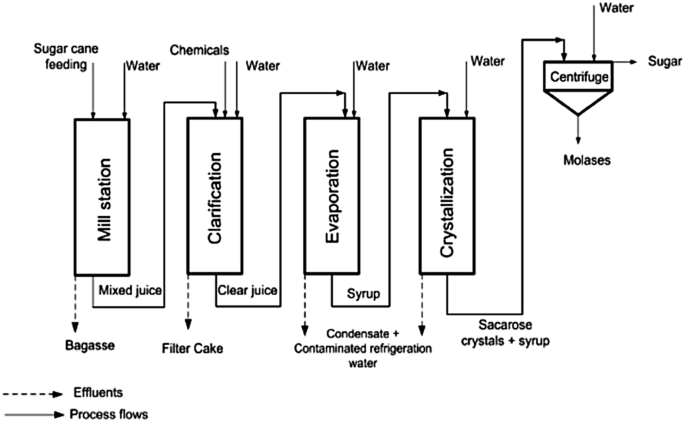How Products From Sugarcane Support Local Agriculture and Jobs
Discover the Cutting-edge Advantages of Products From Sugarcane for Lasting Living
Sugarcane has actually arised as a crucial source in the pursuit for lasting living. Its varied applications span naturally degradable packaging, renewable power, and healthier food options. As sectors look for eco-friendly choices, sugarcane's adaptability supplies promising remedies. However, real potential of sugarcane expands past its existing usages. Discovering its cutting-edge advantages can reveal brand-new paths toward a more sustainable future. What other opportunities might this impressive plant hold?
The Surge of Sugarcane as a Sustainable Resource
As worldwide awareness of ecological concerns grows, sugarcane has actually emerged as a famous lasting resource. This flexible plant provides an array of advantages that add to green methods. Sugarcane is a renewable source, with the ability of prospering in varied climates while absorbing co2, consequently minimizing greenhouse gas discharges. Its rapid growth cycle enables frequent harvesting, resulting in a constant supply of raw material.Additionally, sugarcane growing typically calls for much less water compared to various other plants, making it an efficient alternative in water-scarce areas. The byproducts of sugarcane, such as bagasse and molasses, can be repurposed for different applications, reducing waste and advertising round economic situation principles. Advancements in farming techniques have actually led to even more lasting farming approaches, additionally boosting sugarcane's ecological profile. As customers progressively seek sustainable alternatives, sugarcane stands apart as a sensible option for those devoted to decreasing their ecological footprint.
Biodegradable Product Packaging Solutions
Exactly how can naturally degradable packaging remedies transform the method consumers approach sustainability? By utilizing sugarcane-based products, these ingenious remedies supply an engaging option to standard plastics. Naturally degradable product packaging made from sugarcane decomposes normally, considerably decreasing landfill waste and greenhouse gas discharges. As customers become progressively conscious of their ecological influence, the demand for sustainable product packaging remains to rise.These sugarcane-derived items not only serve practical objectives yet likewise align with eco-conscious customer worths. They offer a concrete means for individuals and services to add to a circular economic climate, advertising resource efficiency and decreasing environmental footprints. In addition, as sectors adopt eco-friendly choices, they foster a culture of sustainability that reverberates with a growing market looking for responsible choices.In significance, naturally degradable packaging options from sugarcane represent a vital advance in sustainable techniques, encouraging consumers to make environmentally pleasant decisions without compromising benefit or high quality.
Renewable Power Generation From Sugarcane
A substantial part of renewable energy generation can be stemmed from sugarcane, showcasing its flexibility beyond conventional farming usages. Sugarcane biomass, including bagasse and leaves, is a powerful resource for bioenergy production. This biomass can be exchanged biofuels such as ethanol, which functions as a cleaner choice to fossil fuels. Furthermore, the combustion of sugarcane results creates vapor and power, giving a power resource for sugar mills and neighboring communities.The growing of sugarcane additionally adds to carbon sequestration, as the plants soak up carbon dioxide throughout their development cycle. By using sugarcane for power, waste is reduced, and lasting techniques are encouraged. This eco-friendly power technique not just sustains energy needs however additionally promotes rural advancement, producing work in bioenergy sectors. On the whole, sugarcane attracts attention as an essential player in the shift to lasting energy remedies, straightening with international efforts to decrease carbon impacts.

Eco-Friendly Textiles and Fabrics
Green fabrics and materials stemmed from sugarcane provide an encouraging option to conventional products. These naturally degradable options not just minimize ecological impact but likewise offer durability and efficiency equivalent to conventional fabrics. Sustainable manufacturing procedures additionally enhance their appeal, making them an essential component of a lasting lifestyle.
Naturally Degradable Fabric Alternatives
Why is the change toward biodegradable fabric alternatives vital for lasting living? The raising awareness of environmental deterioration has prompted a look for alternatives to conventional fabrics, which frequently add to air pollution and waste. Eco-friendly fabrics, derived from renewable energies such as sugarcane, offer a promising option. These materials decay naturally, decreasing landfill build-up and lessening ecological effect. In addition, they can assist lower carbon impacts and reliance on fossil fuels. As consumers become more eco-conscious, the need for lasting textiles expands, encouraging producers to spend and introduce in naturally degradable choices. This adjustment not just sustains lasting techniques however additionally promotes a circular economic situation, leading the means for a more accountable strategy to style and fabric manufacturing.
Sturdiness and Efficiency
Sturdiness and performance are crucial variables when evaluating green textiles and fabrics. Sugarcane-derived materials demonstrate remarkable stamina and strength, making them suitable for various applications. These textiles typically exhibit superior moisture-wicking homes, which improve comfort in everyday wear. Furthermore, their natural fibers add to breathability, guaranteeing that garments stay wearable and fresh also in requiring conditions. The efficiency of sugarcane-based textiles encompasses their resistance to deterioration, permitting products to maintain their honesty with time. Moreover, these green textiles can be treated to improve UV protection and stain resistance, fulfilling the sensible demands of customers without compromising sustainability. Inevitably, sugarcane fabrics offer an unified equilibrium of longevity and performance, appealing click here for more info to eco aware people.
Sustainable Production Processes
The impressive resilience and efficiency of sugarcane-derived fabrics are matched by sustainable manufacturing procedures that prioritize environmental obligation. These procedures make use of renewable energies, decreasing dependence on fossil fuels and lowering carbon footprints. By taking advantage of the by-products of sugarcane farming, manufacturers can develop environment-friendly fabrics while promoting waste reduction. Advanced strategies, such as water-efficient dyeing and biodegradable therapies, better enhance the sustainability of these fabrics. In addition, using safe chemicals guarantees that the manufacturing process does not hurt communities or human health. This dedication to sustainability not just charms to eco aware customers yet additionally supports local economic situations by promoting sustainable farming methods. On the whole, sugarcane-derived fabrics stand for a substantial step in the direction of a greener future in the style sector.
Sugarcane-Based Biofuels and Their Influence

Sugarcane-based biofuels have actually emerged as a substantial different power source, supplying an eco-friendly option to the globe's growing energy demands. These biofuels, originated from the fermentation of sugarcane juice or molasses, offer a more sustainable choice compared to nonrenewable fuel sources. Their production process generates reduced greenhouse gas emissions, adding to environment modification reduction efforts.Additionally, sugarcane biofuels can enhance power safety and security by diversifying energy resources and minimizing reliance on imported oil. The growing of sugarcane also advertises country growth, developing jobs and stimulating regional economies.However, issues pertaining to land use and food competitors linger, as boosted biofuel manufacturing might influence food supply chains. Sustainable farming practices are necessary to balancing these making sure and contending passions that biofuel manufacturing does not weaken food safety. Overall, sugarcane-based biofuels represent a promising opportunity for a greener power future, gave that their social and ecological ramifications are meticulously handled.
Healthier Alternatives: Sugarcane in Food Products
While lots of consumers look for much healthier choices in their diet regimens, sugarcane items use a healthy option to improved sugars and sweetening agents. Stemmed from the all-natural removal of sugarcane juice, these items maintain important nutrients, including nutrients, that are usually lost in refined sugars. Sugarcane has antioxidants and dietary fiber, adding to total health and wellness and wellness.Many health-conscious people are transforming to sugarcane syrup and jaggery, which offer a reduced glycemic index contrasted to conventional sugars, making them ideal for those taking care of blood glucose degrees. Furthermore, sugarcane-derived sugar can boost the taste of various dishes without the adverse results connected with synthetic additives.This shift in the direction of all-natural artificial sweetener not only advertises much better nutritional options yet additionally straightens with lasting living methods, as sugarcane is a renewable energy. Sugarcane items are arising as positive choices in the domain name of food items.
The Future of Sugarcane in Sustainable Innovations
The future of sugarcane is positioned to include innovative applications that see it here extend beyond conventional usages. Its prospective as a source for eco-friendly packaging options and renewable resource sources highlights its function in lasting techniques. Checking out these developments might significantly affect ecological preservation and resource management.
Biodegradable Product Packaging Solutions
An increasing number of business are transforming to biodegradable product packaging options stemmed from sugarcane as an encouraging option to standard plastics. These ingenious materials, typically made from sugarcane fibers and bioplastics, decompose normally, decreasing the long-lasting environmental effect related to conventional plastic waste. By utilizing renewable energies, sugarcane-based packaging adds to a more sustainable manufacturing cycle, lining up with worldwide initiatives to deal with air pollution and environment change. In addition, these solutions frequently preserve the toughness and performance needed for numerous applications, from food containers to shipping products. As customer demand for eco-friendly options expands, companies adopting sugarcane packaging not just enhance their brand picture however additionally play a crucial role in promoting a round economic situation, leading the way for a greener future.
Renewable Resource Resources
Biodegradable packaging options are just one element of the more comprehensive potential of sugarcane in advertising sustainability. One more significant application depends on renewable power sources. Sugarcane is a flexible plant that can be used to create biofuels, such as ethanol, which functions as a cleaner option to nonrenewable fuel sources. The fermentation procedure of sugarcane juice returns ethanol that can power cars and create electrical power. Additionally, the results of sugarcane processing, like bagasse, can be made use of to create biomass energy, using a reliable and lasting approach to harness power. This twin function as both a source of biofuel and biomass underscores sugarcane's potential in decreasing carbon discharges and supporting a change to a more lasting energy landscape in the future.
Often Asked Concerns
Exactly How Is Sugarcane Harvested Sustainably?
Sugarcane harvesting can be sustainable via methods like hand-operated cutting, which lessens soil interruption, and making use of machinery that lowers gas intake (Products From Sugarcane). Crop turning and integrated parasite administration further boost environmental health and promote lasting dirt fertility
What Are the Environmental Effects of Sugarcane Farming?

Can Sugarcane Products Be Reused?
The inquiry of whether sugarcane products can be reused exposes a positive overview. Lots of sugarcane-derived materials, such as bioplastics and product packaging, are created for recyclability, adding to a much more lasting waste management technique within ecological considerations.
Exist Any Type Of Drawbacks to Utilizing Sugarcane-Based Products?
The drawbacks of using sugarcane-based items consist of possible land usage competition with food crops, difficulties in massive production, and concerns regarding the ecological effect of monoculture farming practices, which can reduce biodiversity and dirt wellness.
Exactly How Does Sugarcane Farming Affect Citizen Communities?
Sugarcane growing impacts local areas by supplying employment possibility and improving regional economic situations. Nonetheless, it can likewise cause land disputes and environmental worries, affecting farming techniques and neighborhood health, demanding a well balanced strategy to growth. Improvements in agricultural techniques have actually led to even more sustainable farming approaches, additionally improving sugarcane's environmental account. Additionally, the combustion of sugarcane results produces vapor and electrical power, supplying an energy resource for sugar mills and nearby communities.The farming of sugarcane additionally adds to carbon sequestration, as the plants absorb carbon dioxide throughout their growth cycle. By using sugarcane for power, waste is minimized, and sustainable methods are motivated - Products From Sugarcane. Sugarcane contains anti-oxidants and dietary fiber, contributing to general wellness and wellness.Many health-conscious individuals are turning to sugarcane syrup and jaggery, which offer a reduced glycemic index contrasted to traditional sugars, making them appropriate for those managing blood sugar levels. Furthermore, the byproducts of sugarcane processing, like bagasse, can be used to generate biomass energy, using a sustainable useful link and effective method to harness energy